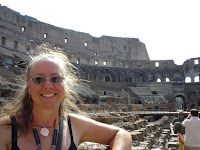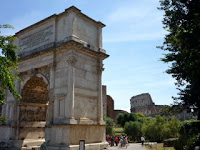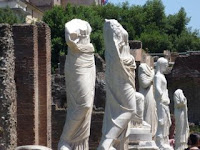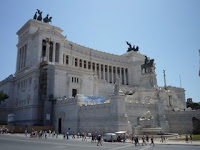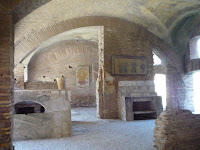While Kyle spends the rest of the month in the USA, I’ve been pottering about the boat and small town of Fiumicino and not really achieving much in the way of anything to show for it. Housework is such a short term high, and no matter how wonderful a job you do of it, it always seems to need doing again so soon.. Yuk!
Having realized I hadn’t done anything adventurous for a while, and yet I’m practically IN ROME I looked again as to ‘what can I do’; I’m still trying to avoid the top Rome sites so I can share them with Kyle – EUR seemed a sensible choice not least because it is where the bus goes!
A suburb of Rome, purpose built for a 1940’s exhibition that never was (a war kind of interrupted things), EUR actually stands for Roman Universal Exhibition (or it does when you say it in Italian – Esposizione Universale di Roma).
The district is described as "Mussolini’s Orwellian quarter" in my guidebook, it’s been built with travertine facades (looks like marble form a distance) that give you a feel for the whiteness of Rome in it’s day.








Every building has a story that I'll leave you to discover on your own one day - but you can probably spot the Palace of the Workers - affectionately know as the 'square colosseum'
There are lots of museums, that I didn’t make the time to explore, I just wandered up and down the streets with no particular goals.
The pictures make EUR look a lot more perfect that it is. In reality ever other block seems to have MAJOR building works. Pavements, pedestrian underpasses, etc. are blocked off, and every gap between buildings if filled with roaring traffic of too many lanes to dare cross. Where there are open piazza(s), these have been turned into parking areas and really make the place look generally ugly, with the occasional oasis.
One of the more famous building sites (well, the thing they are building and the designer are famous) is to be the new Nuvola (Cloud) Conference center (a steel/Teflon ‘cloud’ suspended in a glass box, and the big meeting hall is one of the floors in the cloud!)… Doesn’t look too impressive yet, and I can’t quite say I ‘get it’, but I’m all for variety! I wonder if I’ll be equally inspired by the skies of Greece as the architect Massimiliano Fuksas was?


The 'Cloud', now, and later. Obviously I borrowed the 'done' picture, but my source did not indicate the owner - so thanks owner of image - you deserve all the credit!
On my way back to the bus station I was determined to stop at a recommended café, housed in the Exhibition Ticket office and with original 1930s/40s fittings for ‘aperitivo’. The Caffé Palombini. Technically aperitivo is a drink used to stimulate the appetite, a pre-dinner drink, but bars that offer it generally also provide snacks to nibble on (hence saving the need to dine at all if you are on a budget, and not too hungry). As I sat at an outside table in the sun, I looked around to see what people were drinking. There were a few cokes, coffees, and beers, but most people had tall glasses of very interesting colours (Orange, green, etc)… I really wanted to know more, but chickened out and ordered a white wine (sorry, maybe next time). It was a great place to people watch and was a really mixed bunch: businessmen, lovers, small groups of young lads, and of elderly women, oh and the classic aloof waiters also (but so well dressed).



I enjoy my aperitivo, while nearby locals bring their own table and chairs to enjoy a game of cards in the shaded park!
{Caffé sign from their own website}
My drink came with my snacks (in portions clearly meant for at least two people; I guess they don’t expect many customers to be doing such a social thing on their own), and I nibbled, sipped, and soaked it all up. Wishing Kyle was there to share with me; maybe next time.
Since my visit I’ve found a couple of great links on the internet that help me understand things a little better, so I’m hoping to be braver next time! (Kyle, that’s homework for you!): The Aperitivo Tradition and Guide to Italian aperitivo





